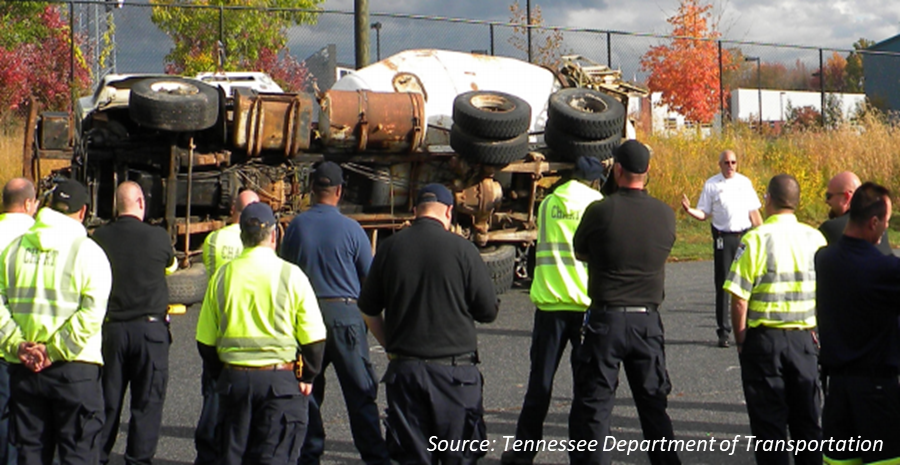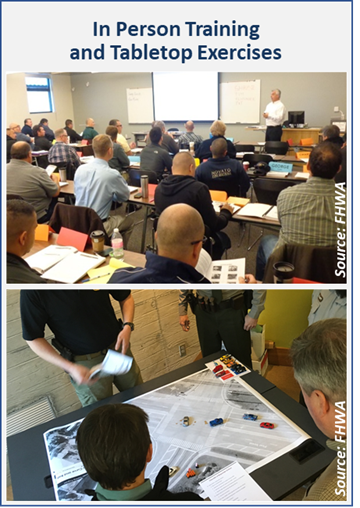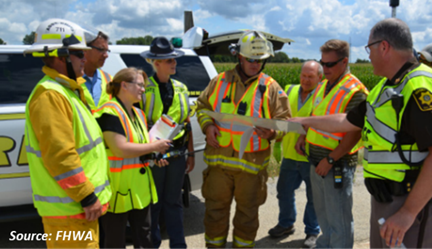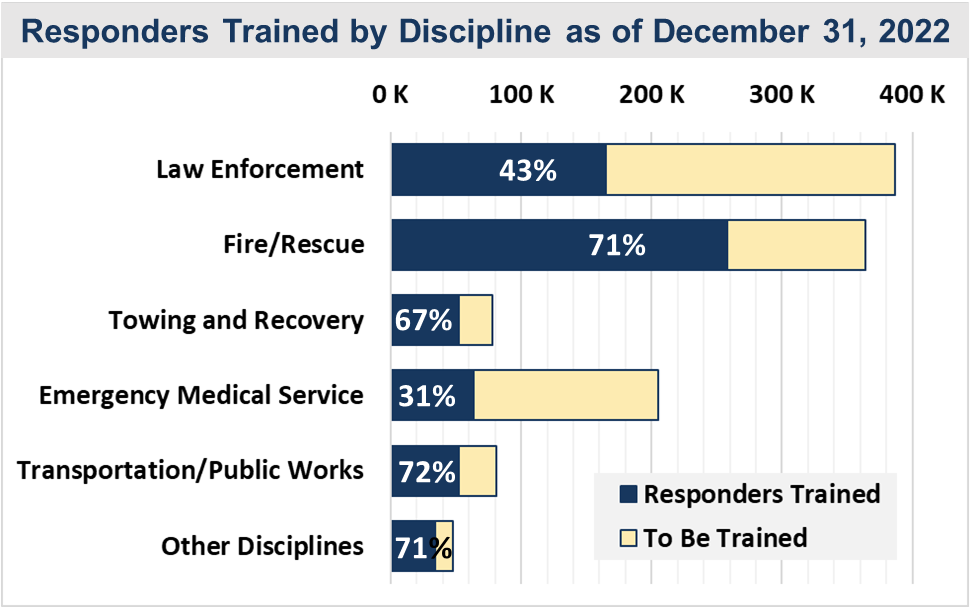

|
||
|
|
National Traffic Incident Management Responder TrainingQUICK LINKSContact List to schedule your in-person training. Free Online National Highway Institute (NHI) training - the NHI course delivers self-paced, web-based training. Free online training– the Responder Safety Learning Network offers NHI-equivalent training. Every minute of every day, incident responders put their lives at risk responding to traffic incidents. In the year 2020, even with significantly lower traffic, 46 responders were killed. In the year 2021, 65 responders were killed, which is over a 40-percent increase from the previous year. The year 2022 showed a positive correction, with 50 line-of-duty deaths in the United States. Untold is the far greater number of life-altering injuries responders incur each year while working at a traffic incident scene. The National TIM Responder Training course is a key part of mitigating deaths and injuries across the responder community. The 4-hour National Traffic Incident Management (TIM) Responder Training course teaches every responder community how to safely and quickly clear traffic incidents. Traffic incident responders include emergency medical service (EMS), transportation and public works, fire and rescue, law enforcement, towing and recovery, and other professionals who support traffic incident management. Efficient incident response requires seamless collaboration and coordination among responders to meet the needs of those injured, ensure the safety of responders and road users, quickly clear the incident, and prevent secondary crashes. Through the following links, you can learn about and access free National TIM Responder Training options, decide whether the training is right for you, view national and State-level training statistics, and understand how the training came to be:
As of May 2023, more than 650,000 responders have completed the National TIM Responder Training course. Additionally, many fire, EMS, and law enforcement training academies have incorporated the National TIM Responder Training into their curricula. The FHWA, collaborating with responder communities, has set a 1.3 million cumulative goal for the number of responders completing the National TIM Responder Training. For more information on how your academy, technical college, or towing association can institutionalize the National TIM Responder Training, please reach out to Jim Austrich, FHWA. Free National TIM Responder Training OptionsThe National TIM Responder Training course covers notification and scene size-up, safe vehicle positioning, scene safety, command responsibilities, traffic management, special circumstances, and clearance and termination. Upon completion of the course, participants will be able to:
Individuals have the option to attend an in-person 4-hour course, or complete an online self-paced training. Some responders will also focus on deeper training (Train the Trainer) that will teach individuals to deliver the National TIM Responder Training course. An interactive instructor-led virtual training is also an option in some areas.

This image is provided by the Tennessee Department of Transportation and it depicts a training session of first responders taking place outdoors. The training involves a mock-up of a crash scene with a rolled over truck. The responders are listening to the instructor as he speaks and points to the rolled over truck.
Free In-Person Training
The two images have been provided by the Federal Highway Administration and depict scenes from In-person training of first responders taking place in a classroom setting. The purpose of the images is to depict how classroom in-person trainings can look and what activities they may involve.
Whenever possible, responders are encouraged to take the 4-hour, in-person training, which brings law enforcement, fire and rescue, transportation, public works, towing and recovery, public safety dispatch, medical personnel, and other incident responders together to foster relationships and engage in interactive training. The in-person training is sponsored by TIM agencies throughout the United States. Responders can learn how to work together in a coordinated manner—from the moment the first emergency call is made to final scene clearance. Please reach out to a TIM training contact for your State to learn about upcoming in-person training opportunities. If you cannot reach the appropriate contact(s) in your State, please let us know, and we'll be happy to help facilitate.
Free Online Self-Paced TrainingThere are two options for online training. You can choose the National Highway Institute (NHI) free-web-based training (course number 133126A) if you would like to learn the content through a single integrated course, with progress at your speed (can stop and resume later). For this training option:
This image is a screenshot of the National Highway Institute (NHI) webpage for first responder free-web-based training. The page starting from the top and moving down, is: On the first line, Course Description. On the second line the name of the training is given as National Traffic Incident Management Responder Training - Web-based. On the third line, the Program Area is stated as Design and Traffic Operations. On the fourth line the Course Number is given as FHWA-NHI-133126A. On the fifth line, the classification of the training is given as Web-based Training (WBT). On the sixth line, more information is given for the calendar year, the length of the course being 4.1 hours, the number of credits for the course which are 0.4 units, and the price which is zero dollars (or otherwise free). On the seventh line, Training Level is indicated as Basic. To the right, a button is provided that reads Add To Cart.
Alternatively, you can choose the Responder Safety Learning Network for modular training.
Free Instructor-Led Virtual TrainingThe FHWA piloted the TIM Responder Instructor-Led Virtual Training (ILVT) in the year 2020, recognizing it can reach a much broader audience and enable thousands more responders to obtain this training. This training method enables responders in various locations to work together to learn and demonstrate response techniques in the virtual classroom environment with a qualified instructor. Consistent with the in-person training, ILVT participants are encouraged to assume the responsibility of a different responder discipline during the exercises so they may consider what the others need to do and what challenges they face during response operations. Using web browser-based real-time maps to simulate an incident scene, participants place responder vehicles, signage, traffic cones, and other necessary objects on the map for a fully interactive experience. Free Train-the-Trainer ProgramThe National TIM Responder Train-the-Trainer (T-t-T) program provides course participants with the knowledge and materials necessary to conduct the TIM training of TIM responders in their area or State. The National TIM Responder Training Program: Train the Trainer course is delivered through 8 lessons, typically over 8 hours, and includes:
Optional hands-on and outdoor activities, including a tabletop exercise, promote communication and collaboration among responder disciplines and provide responders with an opportunity to demonstrate TIM core competencies. The activity may be facilitated through an online collaborative tool that uses real-time maps and locations customized for different States and locales.
Upon completing the T-t-T program, individuals are encouraged to support and then lead two or more training courses annually. To learn more about the T-t-T program and the next course, please reach out to Jim Austrich, FHWA. Why Take the National TIM Responder Training?Why take the 4-hour National TIM Responder Training course? Because it works. The benefits from this training can be multifold, saving lives, time, and costs associated with incidents. The target audience for the training is any TIM responder or TIM support professional, including emergency management, emergency medical service, fire and rescue, law enforcement, public works, towing and recovery, transportation safety service patrol, traffic management center, and public safety dispatch at State, regional, or local levels. Saving Lives
Saving Time
Saving Money
Origins of TIM Responder TrainingThe TIM Responder Training was developed by responders for responders to ensure the right information is delivered in the right way. The training was developed through the Second Strategic Highway Research Program (SHRP2) in 2012 and promoted through the FHWA Every Day Counts Round 2 (EDC-2) Program from 2013 to 2014. 
The image is provided by the Federal Highway Administration (FHWA) and it depicts a group of first responders outdoors. A sheriff's vehicle is parked immediately behind the responder group, performing an after action review. The responders are wearing their protective gear, including retroreflective vests and safety hats.
Training Performance MeasuresAt the close of 2022, more than 630,000 emergency responders had been trained, whether through in-person or web-based training. The chart below shows training by the responder community. The nation is well on its way to meeting its goal to train 1.3 million first responders. Please help promote the National TIM Responder Training for your region. For more detailed State-based training performance measures, please reach out to Jim Austrich, FWHA. . 
Bar graph shows the number of responders that were trained compared with the total who need to be trained, as of December 31, 2022, by discipline. Responder communities are over 65% TIM trained with the exception of law enforcement and EMS, at 43% and 31%, respectively.
Contact UsJim Austrich Paul Jodoin Joseph Tebo
|
|
| US DOT Home | FHWA Home | Emergency Transportation Operations Home | Operations Home | Privacy Policy | ||